The launch of Sputnik in 1957 forced the United States into the space race. Fighting the Cold War, the Americans needed to show the world that they too could launch a rocket into space — and they had to do it quickly. Less than three months later Explorer 1 was launched from Cape Canaveral, Florida. The man behind it: William Pickering from Wellington, New Zealand.
In the next ten years, Pickering went on to become a pivotal figure in the American space race. Once he and his team had conquered the earth’s orbit, the sky was, literally, the limit. He worked at marrying the possibilities of technology with humanity’s wonderment at outer space. By sending spacecraft to the far edges of the solar system, they made us more aware of the galaxy we live in.
William Hayward Pickering was born in Roxburgh Street, Mount Victoria, Wellington in 1910. His mother died when he was six and he was sent to live with his grandparents in Havelock, in the Marlborough Sounds at the northern tip of the South Island. He attended Havelock Primary School, the second school of New Zealand’s greatest scientist, Ernest Rutherford.
The Road to Caltech
In 1923, William started boarding at Wellington College. His father, a pharmacist, had left New Zealand to work in the tropics; an environment he didn’t believe was healthy for his sons. The young Pickering was inspired by his maths teacher, AC ‘Pop’ Gifford. Mr Gifford founded the school’s observatory, the place William first looked through a telescope towards the heavens.
Pickering’s ability to marry practical and theoretical science was coached at Wellington College. With schoolmate Fred White (later Dr F. White CBE, CEO of the Commonwealth Scientific and Industrial Research Organisation) Pickering built an early radio station. The two communicated by Morse code with others around the world.
After high school Pickering studied engineering at Canterbury University. He completed one year of study before an uncle (who divided his time between living in New Zealand and California), encouraged him to apply to the California Institute of Technology (Caltech). Although a new university, Caltech already had an excellent reputation for science and engineering.
Pickering completed a bachelor degree in electrical engineering in 1932, and returned to New Zealand hoping to work as an engineer. Unable to find satisfactory employment, however, he returned to California and to education. He completed his Masters in 1933 and a PhD in Physics in 1936.
That same year he joined the Caltech faculty, teaching electrical engineering. He was made professor in charge of radio and electronics and also appointed to the Scientific Advisory Board of the United States Air Force. As the cold war unfolded the link between academic bodies, research organisations, and the military grew. Caltech, along with MIT, Berkeley, University of Chicago and other notable American institutions, became part of the mix.
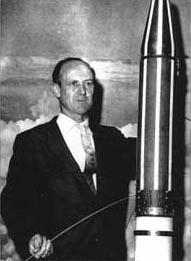
William Pickering 1965
JPL and Explorer 1
During World War II Pickering had become involved in the Jet Propulsion Laboratory (JPL). Jet technology was comparatively new to Caltech, but war was to quickly advance the technology from theory to reality. The American military knew it and enlisted the aid of academic institutions. Pickering initially became involved with the Lab through his studies into telemetry – the science of radio control.
In 1950 he finished lecturing and began working with JPL full time. By 1954 he was the Lab’s Director. His rise to the top was to do with both how well he knew science and how well he knew scientists. His role of director was a multifaceted one: not only was his scientific and technical expertise to the fore, but his antipodean diplomacy was required to lead not only volatile and brilliant scientists, but also work with politicians and military hierarchy during the pressure-cooker political environment of the Cold War.
Sputnik and The Race For Space
On October 4,1957 the Soviet Union launched Sputnik. After 10 years of Cold War the Soviets had beaten the Americans into space. Circling the globe every 90 minutes, Sputnik contained a beeping transmitter that could be received by any short wave radio on earth. The American public knew it was there.
In a 1993 lecture at the University of Michigan, Pickering said the launch of Sputnik was no secret. In 1955 both the Soviet and American governments had announced their intentions to experiment with satellite. If the public wasn’t listening when these announcements were made, two years later they certainly heard the sound of a sinister Sputnik coming over the airwaves above middle America. Or as Pickering said:
“It was only the beeping reality of Sputnik that suddenly made the threat of intercontinental atomic warfare with ballistic rockets more than a science fiction story.”
The Americans were working to match Sputnik, and two months after the Russians’ success the Naval Research Laboratory launched the Vanguard. A test launch, on December 7th, 1957, was to be viewed under the glare of the international media, the craft exploded on the launchpad.
Fortunately, Pickering and the JPL had been working since Sputnik on their own satellite. If their launch went successfully it would repair some of the US Government’s bruised ego.
Explorer 1 was sucessfully launched from Cape Canaveral, Florida on January 31, 1958, less than four months after Sputnik. It orbited the earth for the next 10 years.
The Cold War Heats Up
Working with Pickering was a cosmic ray expert from the University of Iowa, Dr James Van Allen, and Dr Wernher von Braun. The latter was the German rocket scientist who was the masterminded the deadly V2 rockets that devastated London during World War II. Pickering was the Lab Director; he had to bring these two geniuses together for a common goal in an incredibly short time frame, while breathing down their necks were the Government, the Pentagon and the patriotic demands of the American people.
Washington DC was cold and wet the night of February 1st, 1958, hours after the successful launch of Explorer 1. Pickering, Van Allen and von Braun drove through the windswept, deserted streets between the Pentagon and the National Academy of Sciences. They knew the importance of what they had achieved, but were uncertain about how much interest, outside of scientific circles, it would generate.
They needn’t have been concerned. Despite the inclement weather and the fact it was after midnight, a press gang had turned out in force to question the trio. A photo from the press conference of the men holding a model of Explorer 1 represents both the entry of America into the space race and William Pickering’s proudest moment.

Pickering, Van Allen and Von Braun hold a model of Explorer 1, February 1, 1958 – America had entered the space race Copyright http://www.corbis.com
Explorer 1 made the discovery that a radiation belt circled the Earth. This would become known as the Van Allen Belt. A later satellite, Explorer III, launched in December 1958, discovered a second radiation belt at a much higher altitude. Yet Explorer’s scientific discoveries were secondary in the minds of the American public, who felt equal parts of fear and wonder: Explorer’s launch was the starting shot of the space race and the Cold War had immediately become more intense. The conquest of space, the last frontier, had begun.
Venus and Mars
In 1958 Congress passed the Space Act that established the National Aeronautics and Space Administration (NASA). This divided space development research into civilian (NASA’s area) and military, which became the Air Force’s territory. This allowed Pickering and JPL a far freer hand in their work. They were given a contract containing three broad categories for their space missions.
1. Near Earth Satellites. To make measurements of: the Earth from space; to explore the near Earth space environment; and explore the cosmos from observing points above the Earth’s atmosphere;
2. Deep space missions to explore the solar systems;
3. The development of manned space travel.
Pickering said in 1993:
“JPL argued for, and received, a charter to develop the deep space missions. As a personal aside, I was delighted to hold a contract that said in essence ‘go out and explore the depths of the solar system’.”
Wellington to Venus
Despite the aggressive approach taken by the US Government at the time, and which continued after John Kennedy’s election in 1960, American progress in space was slower than the Soviet’s. They were sending more powerful rockets than America’s into space and orbiting the moon. It wasn’t until 1962 when the JPL-designed Mariner II powered to Venus that America could claim a significant ‘first’.
With Explorer I, Pickering helped America take its first tentative steps towards the darkness of space. With Mariner II he and his team were sprinting hard into the great unknown. The American public, bubbling over with optimism and confidence during the prosperous Camelot days, were enthralled.
Pickering was pictured on the cover of Time magazine on March 8, 1963. William Pickering: from Roxburgh Street to Venus.
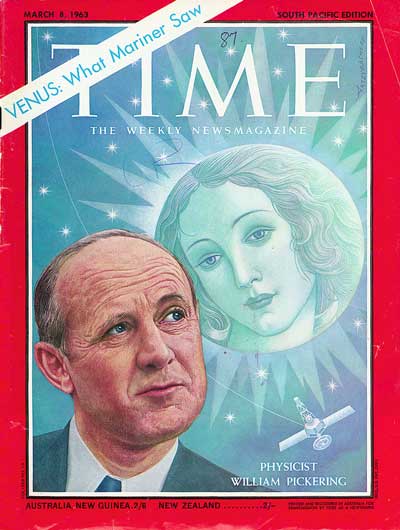
William Pickering on the cover of Time
Venus, close and of similar size to Earth, had long fascinated astronomers, scientists and science fictioneers. Unfortunately for the latter, Venus turned out to be a hot, dry and dead place, only the relatively cool clouds being capable of sustaining life. Any life they could sustain, which was a highly remote possibility, would be dust-size micro-organisms.
Yet, as Time wrote, the fact that Pickering and his team sent Mariner to Venus, was as massive an accomplishment as the findings themselves:
“The very fact that Mariner carried its intricate cargo so far, made so many observations and radioed its reports to Earth with such singular success marks the most important accomplishment in the annals of space exploration. It is a proud first for the US. No achievements by Russian cosmonaut or US astronaut, nor experiment made by any of the myriad other satellites that have been shot aloft has taught man nearly so much as he has learned already from the improbable voyage of Mariner II.”
The following year, on November 28, 1964, Mariner IV was launched towards Mars. On July 23, 1965 Pickering was, once again, on the cover of Time:
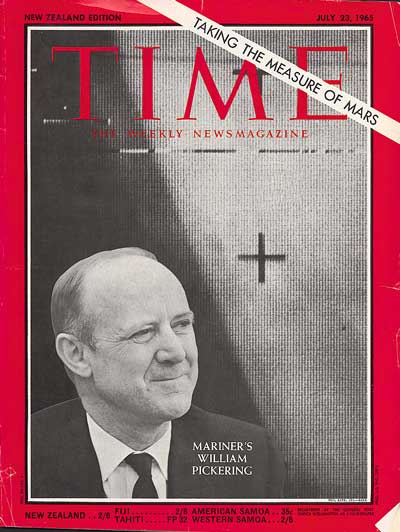
From the Time story:
“While the world watched and waited the ambitious timetable of US space exploration has been put to its most demanding test. And the undulating whine of JPL’s computers seemed to change subtly into a cry of exaltation. Mariner had made it.
“This was the triumphant climax of an eight-month experiment. The pictures pulsing back across the far reaches of space marked the final payoff. For those pictures, JPL boss William Pickering and his crew had sweated out Mariner’s launch from a Cape Kennedy rocket pad; the agile combination of men and computers in the Pasadena lab had solved complex equations of trajectory with split-second precision; the members of the Mariner team had kept a close watch as they monitored their spacecraft’s every signal.”
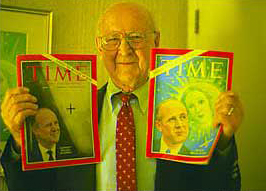
William Pickering 1998, holding the two Time magazines he appeared on the cover of. Copyright of Karen Brown, Wellington
Mariner had travelled 325 million miles in 228 days. It was launched using early-1960s technology, hardly comparable to today’s personal computers. It showed the world photographs of the Martian surface: our first real look at the red planet that humanity had.
The 1960s began with Kennedy declaring that by the end of the decade man would walk on the moon. With only six months of the decade remaining, the promise became reality. Pickering now rates one of his major achievements as the Ranger VII spacecraft returning the first pictures of the lunar surface in 1966. Before this many scientists believed the Moon was covered in a thick layer of dust. Ranger’s observations disproved this, and led the way for Neil Armstrong’s first steps on the lunar surface.
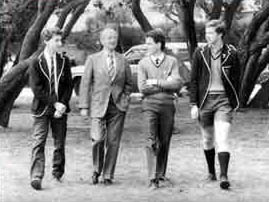
William Pickering visits Wellington College 1983 his former school – when Pickering left school the only satellite of the Earth was the Moon. Permission The Dominion, Wellington
Accolades From Presidents, Queen, Emperor
Pickering retired from JPL in 1976 at the age of 66. He returned briefly to Caltech, before taking up a two-year teaching post in Saudi Arabia. At the age of 68 he returned to the United States with the intention of working on a commercial venture into solar energy. Instead he became director of a company that manufactures processed woodchips. Clean, safe and highly efficient energy may not be as spectacular as deep space exploration, but is still involved in the harnessing and transfer of energy.

William Pickering 1976 receives his knighthood Permission The Dominion, Wellington
William Pickering died at the age of 93 in La Cañada Flintridge, California on 15 March 2004. While he had been a US citizen since 1941, Pickering kept close ties with New Zealand. He had a painting of Mt Cook in his office, retained the faint twinges of a Kiwi accent in his voice, and was given an honorary knighthood from the Queen. The knighthood sits beside American accolades including personal messages from five US Presidents. In 1975 Pickering was awarded the prestigious National Medal of Science by President Gerald R. Ford, and in 1994 he was awarded the Japan Prize by His Majesty, the Emperor of Japan.
In 1993 Pickering was awarded the inaugural Francois-Xavier Bagnoud Aerospace Prize for his contribution to space science. In presenting him with the Prize the then current president of Caltech Thomas E. Everhart said:
“More than any other individual, Bill Pickering was responsible for America’s success in exploring the planets – an endeavour that demanded vision, courage, dedication, expertise and the ability to inspire two generations of scientists and engineers at the Jet Propulsion Laboratory.”
His achievements were recognised by New Zealand in early 2011, when the New Zealand Geographic Board named a Fiordland mountain in his honour. Mt Pickering, standing at 1,650m, is found within the Kelper mountain range 20km west of Te Anau. Mt Pickering lies a mere 5km from the newly named Mt Tinsley – honouring Beatrice Tinsley, another famous New Zealand astronomer and fellow NZEdge hero.
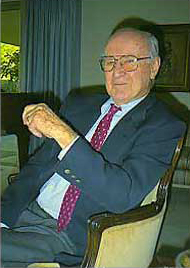
Dr William Pickering at his Los Angeles home, December 1998 Copyright of Karen Brown, Wellington
Sources
Web References:
JPL’s Beacon library have produced a fantastic on-line exhibition, “Faces of Leadership: The Directors of JPL”. Click here for the page on Pickering, including links to a gallery:
http://beacon.jpl.nasa.gov/exhibits/directors/pickeringgal.htm
and here for the general page:
http://beacon.jpl.nasa.gov/exhibits/directors/page1.html
[accessed March 2002]
For an excellent speech detailing Pickering’s achievements and excerpts from his 1993 speech at the University of Michigan see:
http://www.fxb.org/archive/1997/aero3/first.htm
[accessed January 2000]
For a short biography on Pickering see:
http://www.hq.nasa.gov/office/pao/History/sputnik/pickering.html
[accessed January 2000]
also: http://www.biography.com/cgi-bin/biomain.cgi
[accessed May 2000]
Books:
Schefter, James. (1999) The Race, Doubleday New York
Heppenheimer, T.A. (1997) Countdown: A History of Space Flight, John Wiley & Sons, New York
Articles:
Brown, Karen. (1999) “Throwing stones at Venus”, The Evening Post, January 13
Barton, Warren. (1997) “Kiwi who was a rocket scientist”, The Dominion, January 3
(1965) “Taking the Measure of Mars”, Time, July 23
(1963) “Venus: What the Mariner Saw”, Time, March 8
Sites which have linked to this story:
Aeronautics Learning Laboratory for Science, Technology, and Research













"Fantastic website, threatening to make me homesick... Especially interested in the 'Heroes' section. I already knew a lot about Rutherford because he is a sort of academic 'ancestor' for my research, but I only vaguely knew of the others like Pickering, Wilkins and Tinsley, so it was great to learn more about them. Why the hell don't they teach more about these sort of people and their accomplishments in school???" Geoscientist Ottawa, Canada More from Scientists Archibald McIndoe Scientists Archibald McIndoe Motivated by a desire to be more than just an ordinary doctor, Archibald Hector McIndoe pursued greatness and became much more than an ordinary surgeon. Appointed plastic surgeon to the Royal… Sydney Smith Harold Gillies Alan MacDiarmid Alexander Aitken Please leave a comment we’d love to hear your thoughts. Popular Related Latest Nancy Wake John Britten Edmund Hillary Harold Williams Rewi Alley Find NZEDGE on Facebook & Twitter Twitter Feed Tweets by @nzedge Top Legends Tags Peter Jackson Lord of the Rings (The) Maori Rugby China Chicago Tribune Edmund Hillary Sheep World War II Mt. Everest ANZACS Katherine Mansfield Janet Frame Nobel Prize Bruce McLaren Waitangi Day Tenzing Norgay Ernest Rutherford NASA Colin McCahon Nancy Wake DNA Running Formula One Entrepreneur Keith Park Director Archibald McIndoe Alan MacDiarmid South Pole Singer Featured Guinness Book of Records Aviation inventor Arthur Lydiard Richard Pearse Jack Lovelock Opera Shotover Jet Artist Astronomy Jean Batten Musician Motor Racing Cinema Medicine John Britten Kate Sheppard Doctor scientist Author GlaxoSmithKline Irrigation White Mouse Designer William Pickering Poet Allan Wilson Engineer Communities The gateway to New Zealand communities in the world. We'd love to know of anymore and updates and connections to what we have listed, please click here to let us know. Australia Austria Belgium Canada Chile China Denmark Facebook France Germany Hong Kong India Indonesia Ireland Japan Malaysia Netherlands NZ Embassies Philippines Singapore South Africa South Korea Switzerland Taiwan Thailand United Arab Emirates United Kingdom "Fantastic website, threatening to make me hom United States Vietnam"Fantastic website, threatening to make me homesick... Especially interested in the 'Heroes' section. I already knew a lot about Rutherford because he is a sort of academic 'ancestor' for my research, but I only vaguely knew of the others like Pickering, Wilkins and Tinsley, so it was great to learn more about them. Why the hell don't they teach more about these sort of people and their accomplishments in school???" Geoscientist Ottawa, Canadaly 23 (1963) “Venus: What the Mariner Saw”, Time, March 8 Sites which have linked to this story: Aeronautics Learning Laboratory for Science, Technology, and Research NZEDGE.COM EXECUTIVE EDITOR BRIAN SWEENEY Tags: NASA Rocket scientist Rockets Space Sputnik William Pickering Godfrey Bowen Comments Lisa Pickering - 10:50 am on October 28th, 2013 Love reading about the great inspiring achievements of my grand-uncle...thank you for honouring him so well on this website :) Geoscientist - 12:13 pm on May 11th, 2000 "Fantastic website, threatening to make me homesick... Especially interested in the 'Heroes' section. I already knew a lot about Rutherford because he is a sort of academic 'ancestor' for my research, but I only vaguely knew of the others like Pickering, Wilkins and Tinsley, so it was great to learn more about them. Why the hell don't they teach more about these sort of people and their accomplishments in school???" Geoscientist Ottawa, Canada More from Scientists Archibald McIndoe Scientists Archibald McIndoe Motivated by a desire to be more than just an ordinary doctor, Archibald Hector McIndoe pursued greatness and became much more than an ordinary surgeon. Appointed plastic surgeon to the Royal… Sydney Smith Harold Gillies Alan MacDiarmid Alexander Aitken Please leave a comment we’d love to hear your thoughts. Popular Related Latest Nancy Wake John Britten Edmund Hillary Harold Williams Rewi Alley Find NZEDGE on Facebook & Twitter Twitter Feed Tweets by @nzedge Top Legends Tags Peter Jackson Lord of the Rings (The) Maori Rugby China Chicago Tribune Edmund Hillary Sheep World War II Mt. Everest ANZACS Katherine Mansfield Janet Frame Nobel Prize Bruce McLaren Waitangi Day Tenzing Norgay Ernest Rutherford NASA Colin McCahon Nancy Wake DNA Running Formula One Entrepreneur Keith Park Director Archibald McIndoe Alan MacDiarmid South Pole Singer Featured Guinness Book of Records Aviation inventor Arthur Lydiard Richard Pearse Jack Lovelock Opera Shotover Jet Artist Astronomy Jean Batten Musician Motor Racing Cinema Medicine John Britten Kate Sheppard Doctor scientist Author GlaxoSmithKline Irrigation White Mouse Designer William Pickering Poet Allan Wilson Engineer Communities The gateway to New Zealand communities in the world. We'd love to know of anymore and updates and connections to what we have listed, please click here to let us know. Australia Austria Belgium Canada Chile China Denmark Facebook France Germany Hong Kong India Indonesia Ireland Japan Malaysia Netherlands NZ Embassies Philippines Singapore South Africa South Korea Switzerland Taiwan Thailand United Arab Emirates United Kingdom United States Vietnam
Love reading about the great inspiring achievements of my grand-uncle...thank you for honouring him so well on this website :)